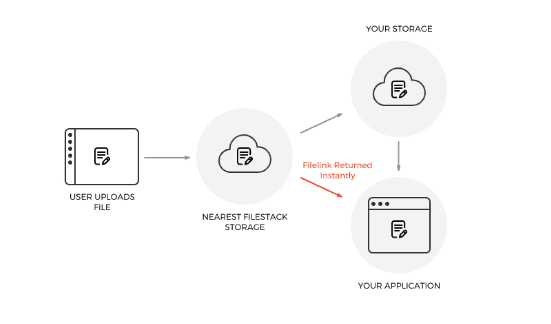There are many websites and web applications that enable users to upload files. Take, for example, social media sites like Facebook and Instagram that allow users to upload images and videos.
Similarly, online image and video editing tools accept files uploaded by users to enable them to edit image and video files.
However, sometimes users upload too large files, say 4-5 GB, which requires lots of space. Additionally, large file upload causes issues related to speed, latency, timeouts, etc., which can frustrate the end users.
As a result, large file uploads are challenging for many developers. However, some ways can help you manage large files efficiently. Read on to learn more.
Why Do You Need To Enable Large File Uploads In Your Applications?
Today, many web apps accept user-uploaded files, such as documents, images, and videos. However, trends show that file sizes have increased over the past few years.
For example, there are now advanced cameras and smartphones that can make HD videos, and the file sizes of such videos are largely due to their high quality. Similarly, the file sizes of high-resolution images are also big.
As a result, apps need to be able to handle large file uploads. However, sometimes cyber attackers can take advantage of file upload and upload files that are too large. This, in turn, can cause the server to malfunction.
For this reason, creating a secure file uploader and handling big file sizes is essential.
What Are The Issues With Big File Sizes In Applications?
There are several issues that developers can face while enabling large file uploads in their applications:
Latency And Speed Issues
Large files require more bandwidth and time to upload than small files. While developers know this, it can be frustrating for the end-user, resulting in a bad user experience.
Speed issues usually occur when you try to transfer the files to your server in a single batch, especially large. This means all files uploaded by end users go to your server through the same route, causing gridlock.
This is similar to when so many people take the same route to a shopping mall or a restaurant, resulting in traffic congestion.
Upload Errors
Uploading errors usually occur due to file size limitations on the web browser of the users or web server. Most browsers these days can handle a maximum of 2GB.
However, there are several reasons for a web server to reject a file upload request. For example, it can be due to network interruption, unstable internet connection, or low bandwidth on the client side.
Additionally, there can be issues when the file size exceeds the server’s memory limit or when the request isn’t processed in the specified timeout period. For this reason, it’s essential to enable maximum memory limits and file upload size for your server.
How To Handle Big File Sizes In Your Apps Efficiently?
Large files can be a pain if they aren’t handled properly. However, you can allow end users and internal teams to upload files easily by following these tips and tricks:
Store Directly To The Cloud
If your files are roaming worldwide and are processed in various locations, they will take longer to upload.
So, it’s best to upload your files directly to your cloud storage accounts, such as Azure, AWS, or Dropbox. This will result in better speed because your files won’t have to make any stops to reach their final destination.
Use S3 Buckets
When you store files directly in the cloud, you also need to ensure your files are stored in the nearest data center or bucket of the cloud service provider. Otherwise, your files might still be traveling halfway around the world, resulting in slower upload and high chances of errors.
Choose The Right Cloud Storage
Many cloud storage services are available today, but not all have the same file size limits.
That’s why it’s essential to choose your cloud storage service wisely. You need to select the service that provides file size limits that’ll work for your app in the long term because file sizes will most likely increase, especially if your app accepts images and video files. Cloud services like Amazon S3 and Google cloud storage provide a file size limit of up to 5TB.
Upload Large Files In Chunks
When you upload files in chunks, you break your large files into smaller pieces and process them periodically using an API. These smaller pieces are more manageable than one single large file.
Uploading in chunks also means that we can resume the upload where it left off, even if there is an issue with one chunk. This way, we don’t have to start from scratch. This is especially helpful when users upload large files from mobile devices where the connection can be unstable.
Choose Asynchronous Uploads
There are high chances of errors, such as those related to network and timeouts, with synchronous uploads. This is especially true when you don’t store your files in S3. With asynchronous uploading, you can upload files in the background while your application continues to function.
Use A Third-Party File Upload Service
Creating an extensive file upload infrastructure from scratch can be challenging and time-consuming.
You can use an API like Filestack file uploading API that can manage the whole significant file upload process for you while ensuring security, speed, and reliability.
With Filestack, you can split your files into chunks and upload them asynchronously to eliminate timeout errors. It also has a Content Ingestion Network (CIN) that can help increase international file upload speeds.
Some third-party services allow users to upload large files (5GB and more) and provide a direct link to the stored files. These include fileshare free, fileupload io, Filemail, and more. Many of these services allow you to upload your files for free.
Conclusion
Handling large files in applications can be challenging. However, to upload large files efficiently, you should:
- Store files directly to the cloud
- Choose the exemplary cloud storage service
- Split large files into smaller chunks
- Ensure your files are stored in the nearest bucket and take the shortest path to your cloud storage
- Upload files asynchronously
Frequently Asked Questions (FAQs)
What does file upload mean?
Many apps, such as social media web apps, enable users to upload different types of files, such as images and videos. Sometimes internal teams also have to upload files, such as product images and videos.
What are the issues with large file uploads?
Some issues with large file uploads include latency issues, timeouts, and slow speed.
Can I upload a 5GB file?
If you choose a cloud storage provider like Amazon S3 or Google file storage, you can upload file sizes of up to 5TB.
































